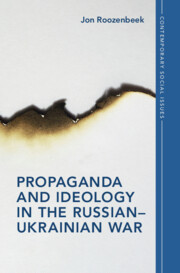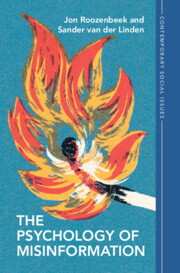201 results
10 - Copenhagen
- from Part II - Living with the Bomb
-
- Book:
- Hitler's Atomic Bomb
- Print publication:
- 18 July 2024, pp 240-267
-
- Chapter
- Export citation
Chapter 15 - Practical Socialism
- from Part IV - Movements and Causes
-
-
- Book:
- The Cambridge Companion to William Morris
- Published online:
- 03 May 2024
- Print publication:
- 23 May 2024, pp 203-214
-
- Chapter
- Export citation
5 - Identity and Ideology in Online Media
-
- Book:
- Propaganda and Ideology in the Russian–Ukrainian War
- Published online:
- 16 May 2024
- Print publication:
- 23 May 2024, pp 83-100
-
- Chapter
- Export citation
3 - Building a Propaganda Machine
-
- Book:
- Propaganda and Ideology in the Russian–Ukrainian War
- Published online:
- 16 May 2024
- Print publication:
- 23 May 2024, pp 49-64
-
- Chapter
- Export citation
4 - Newspaper Narratives in Occupied Ukraine
-
- Book:
- Propaganda and Ideology in the Russian–Ukrainian War
- Published online:
- 16 May 2024
- Print publication:
- 23 May 2024, pp 65-82
-
- Chapter
- Export citation
Introduction
-
- Book:
- Propaganda and Ideology in the Russian–Ukrainian War
- Published online:
- 16 May 2024
- Print publication:
- 23 May 2024, pp 1-6
-
- Chapter
- Export citation
6 - The Consequences of Propaganda
-
- Book:
- Propaganda and Ideology in the Russian–Ukrainian War
- Published online:
- 16 May 2024
- Print publication:
- 23 May 2024, pp 101-116
-
- Chapter
- Export citation

Propaganda and Ideology in the Russian–Ukrainian War
-
- Published online:
- 16 May 2024
- Print publication:
- 23 May 2024
2 - The BJP’s Ideological Heterodoxy
-
- Book:
- The New Experts
- Published online:
- 09 May 2024
- Print publication:
- 16 May 2024, pp 17-59
-
- Chapter
- Export citation
Carl Schmitt and Ossip Flechtheim at Nuremberg: A Crossroads for International Justice and Intellectual History
-
- Journal:
- German Law Journal ,
- Published online by Cambridge University Press:
- 29 April 2024, pp. 1-38
-
- Article
-
- You have access
- Open access
- HTML
- Export citation
1 - Defining Misinformation
- from Part I - Setting the Stage
-
- Book:
- The Psychology of Misinformation
- Published online:
- 28 March 2024
- Print publication:
- 04 April 2024, pp 9-21
-
- Chapter
-
- You have access
- HTML
- Export citation
Chapter 23 - Film
- from Part IV - Arts
-
-
- Book:
- Vaughan Williams in Context
- Published online:
- 28 March 2024
- Print publication:
- 04 April 2024, pp 196-204
-
- Chapter
- Export citation
Chapter 27 - The Second World War:
- from Part V - Institutions
-
-
- Book:
- Vaughan Williams in Context
- Published online:
- 28 March 2024
- Print publication:
- 04 April 2024, pp 232-238
-
- Chapter
- Export citation
9 - Public Diplomacy
-
-
- Book:
- Diplomatic Tradecraft
- Published online:
- 15 March 2024
- Print publication:
- 28 March 2024, pp 197-220
-
- Chapter
- Export citation

The Psychology of Misinformation
-
- Published online:
- 28 March 2024
- Print publication:
- 04 April 2024
Sergei Chakhotin against the Swastika: Mass Psychology and Scientific Organization in the Iron Front's Three Arrows Campaign
-
- Journal:
- Central European History , First View
- Published online by Cambridge University Press:
- 18 March 2024, pp. 1-20
-
- Article
- Export citation
5 - Reception
- from Part I - Contexts
-
-
- Book:
- The Cambridge History of Old Norse-Icelandic Literature
- Published online:
- 08 February 2024
- Print publication:
- 29 February 2024, pp 91-110
-
- Chapter
- Export citation
3 - Pernicious Propaganda
- from Part I - Promised Lands
-
- Book:
- Soviet Adventures in the Land of the Capitalists
- Published online:
- 18 January 2024
- Print publication:
- 22 February 2024, pp 33-41
-
- Chapter
- Export citation
Are propagandists combatants? Analysing the ethical status of propagandists in warfare
-
- Journal:
- Review of International Studies , First View
- Published online by Cambridge University Press:
- 12 February 2024, pp. 1-20
-
- Article
-
- You have access
- Open access
- HTML
- Export citation



